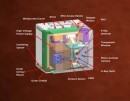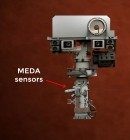It’s not long now until the most important uncrewed mission to Mars in ages will depart Earth. The main purpose of the mission, the specially designed and yet unnamed rover that would land in the Jezero Crater in 2021, is now entering its final testing stages.
The American space agency announced last week the rover is now at JPL’s Simulator Building, where it is undergoing final testing before being mounted on top of the rocket that will get it to its workplace.
For the next few weeks, the rover will be subjected to surface thermal testing in a vacuum chamber, as scientists will try to determine “how its instruments, systems and subsystems operate in the frigid, near-vacuum environment it will face on Mars.”
The rover is equipped with a number of tools that should allow to investigate and possibly find traces of ancient life on the Red Planet. In all, there’s seven of them.
Mastcam-Z is a panoramic camera that will be used to determine the mineralogy of the Martian surface. SuperCam will be used to provide imaging, chemical composition analysis, IXL will be used to detect and analyze chemical elements, and SHERLOC will be used to detect organic compounds.
Other tools like MEDA will be utilized to measure things like temperature, wind speed and direction, pressure, and relative humidity, while RIMFAX will provide centimeter-scale resolution of the geologic structure of the subsurface.
Perhaps the most important tools the rover is carrying to space, when looking at the greater picture, is the MOXIE, a system that will try and generate oxygen from Martian atmospheric carbon dioxide.
The Mars 2020 mission will depart next July and has a planned arrival date for February 2021. Once it gets there, it would become the first human-built- machine with no crew on board that will be able to maneuver out of harm’s way during landing, if need be.
Full details on the rover can be found at this link.
For the next few weeks, the rover will be subjected to surface thermal testing in a vacuum chamber, as scientists will try to determine “how its instruments, systems and subsystems operate in the frigid, near-vacuum environment it will face on Mars.”
The rover is equipped with a number of tools that should allow to investigate and possibly find traces of ancient life on the Red Planet. In all, there’s seven of them.
Mastcam-Z is a panoramic camera that will be used to determine the mineralogy of the Martian surface. SuperCam will be used to provide imaging, chemical composition analysis, IXL will be used to detect and analyze chemical elements, and SHERLOC will be used to detect organic compounds.
Other tools like MEDA will be utilized to measure things like temperature, wind speed and direction, pressure, and relative humidity, while RIMFAX will provide centimeter-scale resolution of the geologic structure of the subsurface.
Perhaps the most important tools the rover is carrying to space, when looking at the greater picture, is the MOXIE, a system that will try and generate oxygen from Martian atmospheric carbon dioxide.
The Mars 2020 mission will depart next July and has a planned arrival date for February 2021. Once it gets there, it would become the first human-built- machine with no crew on board that will be able to maneuver out of harm’s way during landing, if need be.
Full details on the rover can be found at this link.












